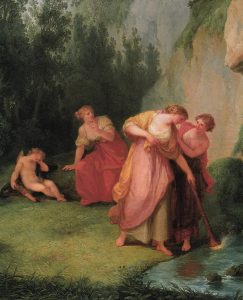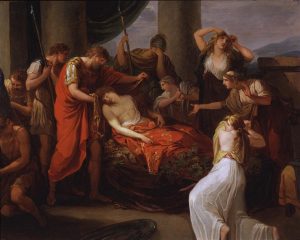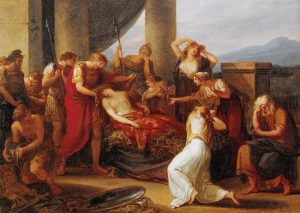Assistants, Copyists and Followers
Edited by Bettina Baumgärtel
Kauffman and Hackert
Today we know that Kauffman carried out joint works with leading artists of her time.
The mythological scene Nymphs extinguishing Cupid’s Torch (Ill. 42) first turned up on the art market in New York in May 1998. On the basis of an examination of the painting carried out the same year by Bettina Baumgärtel and Inken M. Holubec, it was determined that it had been executed by two “hands”. The technological investigation confirmed this speculation and revealed that the rugged cliff at the right edge had been substantially cropped. In actuality, the landscape was the work of Jakob Philip Hackert (1737–1807), court painter to the king of Naples and a friend of Goethe, while Kauffman contributed the group of four figures.
Kauffman and Dell’Era
We have also meanwhile gained further insights into possible pupils, copyists and followers of Kauffman already alive during her lifetime. Especially prominent among the young artists she fostered and instructed in Rome was Giovanni Battista Dell’Era (1765–1799) of Lombardy, whose copies and works in Kauffman’s style have yet to receive the attention they deserve [Bibliography].
Wendy W. Roworth attributed an oil sketch depicting Eneas mourns Palatin killed by Turnus to Angelica Kauffman (Ill. 43, 44).
On the basis of stylistic and technical criteria, Bettina Baumgärtel now attributes the work to Giovanni Battista Dell’Era instead.
The questionable ascription to Kauffman led to misinterpretations of the work’s genesis, since Dell’Era’s oil sketch was regarded a preliminary stage of the final painting. In fact the sketch is not a bozzetto for the famous commission from Emperor Joseph II – i.e. a study carried out in preparation for the work’s execution on a large scale – but a copy by another hand, namely that of Dell’Era. The young artist will presumably have copied it from the oil study by Kauffman, which at the time was in her studio; it would later be purchased from the artist’s estate by the Innsbrucker Landesmuseum. The two large-scale history paintings executed for the Austrian emperor were destroyed by fire in the Führer Headquarters in Berlin in 1945.
Citation note:
Baumgärtel, Bettina: Angelica Kauffman – Assistants, Copyists and Followers, in: Angelika Kauffmann Research Project – online, https://www.angelika-kauffmann.de/en/copyists-and-followers/ [add date of access here]




